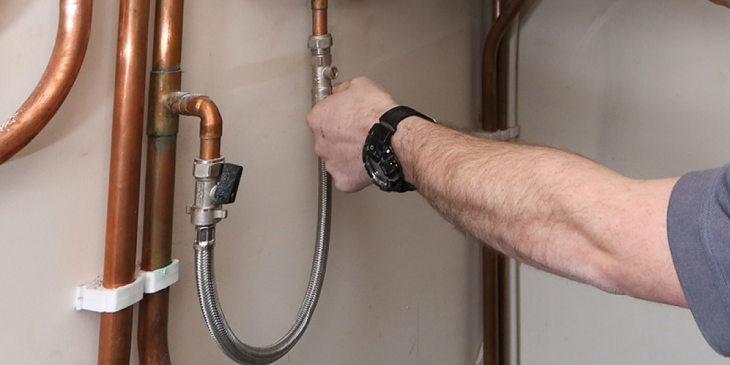Boiler Filling Keys and Loops: What They Are and How to Use Them Safely
Topping up your boiler pressure is a simple but essential maintenance task—and to do it correctly, you’ll need either a filling key or a filling loop. Whether you’re a homeowner keeping your system in check or a heating engineer advising clients, understanding how these tools work (and how to use them properly) is key to preventing pressure-related faults and system damage. This guide explains the purpose of filling keys and loops, identifying your setup, and avoiding common mistakes.
What Are Filling Keys and Filling Loops?
A filling key or filling loop manually top up the water pressure in a sealed central heating system. This restores the correct pressure after bleeding radiators, maintenance, or fault resolution.
- Filling keys are plastic or metal tools that fit into a dedicated housing beneath the boiler. They’re most common in certain Worcester Bosch models.
- Filling loops are flexible braided hoses that connect your boiler to the mains water supply. They’re often found on Ideal, Vaillant, and Baxi systems.
Both tools achieve the same outcome, refilling your boiler’s system with water from the mains.
Why Boiler Pressure Matters
Most boilers operate within a pressure range of 1.0–1.5 bar when cold. If pressure drops too low, the boiler may:
- Lock out or display an error code
- Struggle to circulate water effectively
- Trigger airlocks and cavitation
- Fail to ignite, particularly in combi boilers
By topping up the pressure using a filling key or loop, you restore normal operation and avoid unnecessary engineer call-outs.
How to Use a Filling Key or Loop Safely
Using a Filling Key (e.g. Worcester Bosch):
- Turn off the boiler and let it cool
- Insert the filling key into the housing beneath the boiler
- Turn the key until it locks into place
- Rotate the white knob or control valve to open the mains feed
- Watch the pressure gauge rise to 1.5 bar
- Turn off the valve and remove the key
Using a Filling Loop (e.g. Ideal, Vaillant, Baxi):
- Ensure both ends of the loop are securely attached to the correct valves
- Turn both valves to allow water into the system
- Monitor the pressure gauge carefully
- Close both valves once pressure is between 1.0 and 1.5 bar
- Remove the loop if it’s detachable (store safely)
Important: Never leave the filling loop connected if your system doesn’t require it. Backflow and over-pressurisation can occur.
Common Issues with Filling Keys and Loops
- Lost filling key – one of the most common reasons homeowners can’t repressurise their boiler
- Worn washers or seals – cause leaks during filling
- Loop not connected correctly – can allow air or water to escape
- Overfilling the system – leads to pressure over 3 bar and triggers the PRV
- Loop left attached permanently – against regulations and risks of contamination
If pressure drops after topping up, the issue may lie elsewhere, such as a leaking radiator, faulty pressure relief valve, or failed expansion vessel.
Benefits of Keeping a Working Filling Device
- Restores pressure quickly and safely
- Avoids unnecessary engineer visits for simple top-ups
- Essential for resetting after maintenance or radiator bleeding
- Cost-effective part with major system impact
- Compatible with most combi and system boilers
- Available in OEM and BSI-compliant refurbished options
Expert Insight
“We get countless calls about boiler pressure. Half the time, the issue is a missing key or a poorly fitted loop. It’s a 2-minute fix once you know how.” — Technical Support, NBS
“Leaving a filling loop attached is one of the most common installation errors. It can breach regulations and cause long-term system issues.” — Heating Engineer, Nottingham
When to Replace Your Filling Device
- Key is lost, cracked, or won’t lock into place
- Loop hoses are kinked or leaking
- Washers are perished or missing
- Loop doesn’t maintain a seal under pressure
Always replace with the correct model for your boiler; fitting the wrong size can cause damage or void warranties.
Maintenance Tips
- Store spare keys with boiler paperwork
- Check loop seals annually for signs of wear
- Ensure both loop valves close fully to avoid drips
- Use silicone grease on key fittings for smoother use
- Test pressure monthly, especially in winter months
FAQs
How often should I top up boiler pressure? Ideally, only occasionally—once every few months. Regular top-ups suggest a leak.
What pressure should my boiler be at? 1.0 to 1.5 bar when cold. 1.5 to 2.0 bar when hot is acceptable.
Can I use any filling loop? No—use one designed for your boiler make and model.
What happens if I lose my filling key? You’ll need a replacement before repressurising. Check your boiler manual or call our team.
Is it safe to leave a loop connected? Only if your manufacturer allows it. In most cases, it should be disconnected after use.


